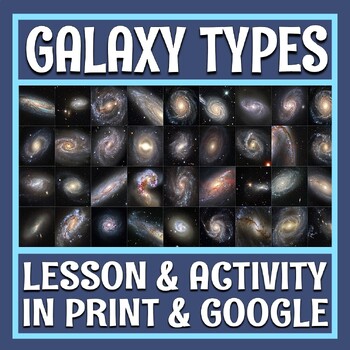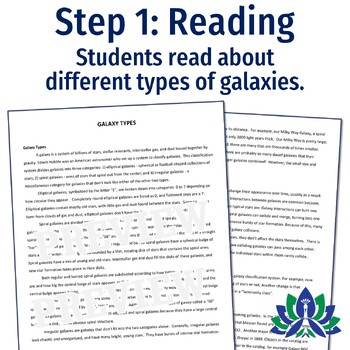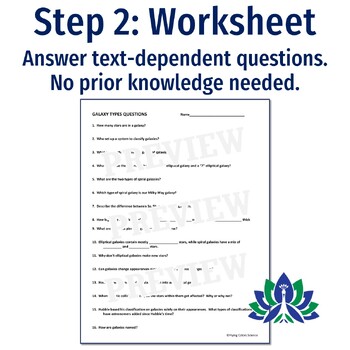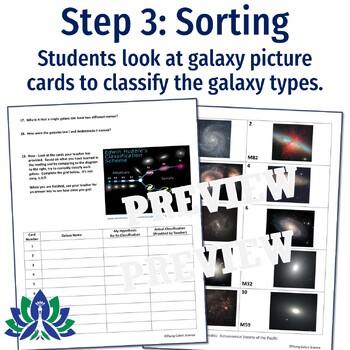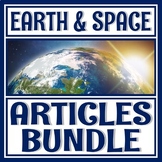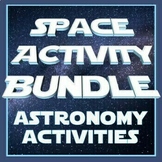Space Astronomy Galaxy Types Activity Classify Objects in Universe
Flying Colors Science
4.8k Followers
Grade Levels
7th - 10th
Subjects
Resource Type
Standards
NGSSHS-ESS1-6
NGSSMS-ESS1-2
NGSSMS-ESS1-3
Formats Included
- PDF
- Google Apps™
- Easel Activity
Pages
6 pages
Flying Colors Science
4.8k Followers

Includes Google Apps™
The Teacher-Author indicated this resource includes assets from Google Workspace (e.g. docs, slides, etc.).
Easel Activity Included
This resource includes a ready-to-use interactive activity students can complete on any device. Easel by TPT is free to use! Learn more.
What educators are saying
I liked that this recourse provided information about the different galaxy shapes. My curriculum has many holes that do not address the types of galaxy shapes but expect students to know them. This help fill in holes.
This was a great resource to add to my astronomy unit. This really hit the mark on galaxy classifications. I used this in conjunction with an interactive notebook activity.
Also included in
- SAVE MORE THAN 30% OFF LIST PRICES with this set of 44 Earth and space science reading comprehension articles. Each resource includes an engaging Earth or space science article and a corresponding worksheet.⭐ All articles include both print and Google Slides versions!In each of these activities, stuPrice $119.00Original Price $177.87Save $58.87
- Save more than 35% off list prices! Includes 10 high-interest activities on the universe, sun, gravity, solar system, galaxies, and astronauts. These space lessons are designed to add FUN and RIGOR to an existing astronomy unit! BUNDLE INCLUDES the Following:Galaxy Types Classification Activity (wPrice $19.99Original Price $31.43Save $11.44
- Never search for "something to do tomorrow" ever again! This bundle contains PRINT AND GO lessons, NO PREP activities, LOW PREP labs, and ENGAGING articles to supplement and thoroughly enhance an Earth and space science course. Every included resource is easy to implement, standards-based, and high-Price $399.99Original Price $639.06Save $239.07
Description
Fun galaxy activity! Perfect addition to a scaled properties of objects in the solar system unit!
GO PAPERLESS and avoid color copies - use the included digital Google Slides version!
⭐Get this activity at a huge discount in our Astronomy Activity Bundle!
In this activity, students will:
- Read about different types of galaxies. (2 pages)
- Answer several text-dependent analysis questions.
- Practice classifying pictures of 10 real galaxies.
Teacher Notes:
- This resource is not editable.
- This resource is adapted from the widely available Astronomical Society of the Pacific galaxy activity. Our version has been significantly simplified and streamlined for a middle school audience.
- INCLUDES ANSWER KEY.
- NGSS HS-ESS1-6, MS-ESS1-2, MS-ESS1-3
- Find more Astronomy Resources in the ASTRONOMY SECTION OF OUR STORE!
⭐ SAVE $$ - Astronomy "EXTRA ACTIVITIES" Bundle ⭐
⭐⭐⭐ Click here to get 5 FREE EARTH & SPACE SCIENCE lessons! ⭐⭐⭐
Total Pages
6 pages
Answer Key
Included
Teaching Duration
N/A
Report this resource to TPT
Reported resources will be reviewed by our team. Report this resource to let us know if this resource violates TPT’s content guidelines.
Standards
to see state-specific standards (only available in the US).
NGSSHS-ESS1-6
Apply scientific reasoning and evidence from ancient Earth materials, meteorites, and other planetary surfaces to construct an account of Earth’s formation and early history. Emphasis is on using available evidence within the solar system to reconstruct the early history of Earth, which formed along with the rest of the solar system 4.6 billion years ago. Examples of evidence include the absolute ages of ancient materials (obtained by radiometric dating of meteorites, moon rocks, and Earth’s oldest minerals), the sizes and compositions of solar system objects, and the impact cratering record of planetary surfaces.
NGSSMS-ESS1-2
Develop and use a model to describe the role of gravity in the motions within galaxies and the solar system. Emphasis for the model is on gravity as the force that holds together the solar system and Milky Way galaxy and controls orbital motions within them. Examples of models can be physical (such as the analogy of distance along a football field or computer visualizations of elliptical orbits) or conceptual (such as mathematical proportions relative to the size of familiar objects such as students’ school or state). Assessment does not include Kepler’s Laws of orbital motion or the apparent retrograde motion of the planets as viewed from Earth.
NGSSMS-ESS1-3
Analyze and interpret data to determine scale properties of objects in the solar system. Emphasis is on the analysis of data from Earth-based instruments, space-based telescopes, and spacecraft to determine similarities and differences among solar system objects. Examples of scale properties include the sizes of an object’s layers (such as crust and atmosphere), surface features (such as volcanoes), and orbital radius. Examples of data include statistical information, drawings and photographs, and models. Assessment does not include recalling facts about properties of the planets and other solar system bodies.

